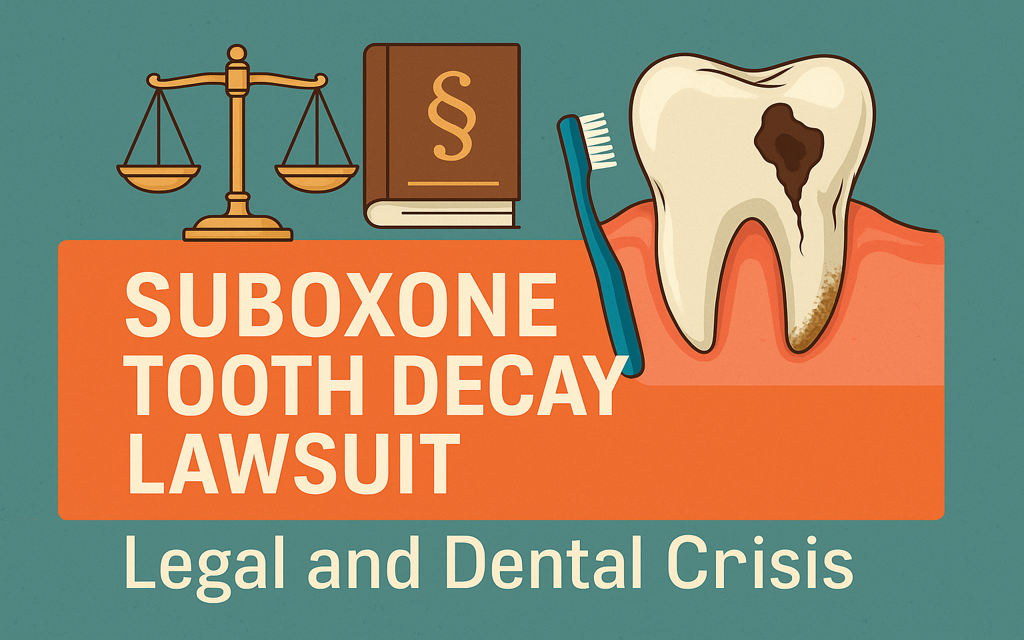The Suboxone tooth decay case is quickly shaping up to be one of the most significant pharmaceutical lawsuits of the decade. Thousands of individuals who placed their faith in Suboxone to cure opioid addiction are now coming forward. They claim to have lost teeth, experienced gum infections, and suffered permanent oral health damage.
Suboxone, a buprenorphine and naloxone-contained medication, is administered by dissolvable film under the tongue. Although the medication curbs opioid cravings, it subjects the mouth to extreme acidity. Gradually, this can lead to enamel wear, loss of tooth structure, and decay.
Patients were not informed about these dental hazards until 2022 when the FDA stepped in. Lawsuits currently assert that Indivior, the maker, did not give timely and sufficient warnings. This article discusses the expanding legal claims, court updates, and public health implications. It provides essential information for patients, families, and professionals working in addiction recovery.
What Is Suboxone and Why Was It Prescribed?
Physicians prescribe Suboxone for the treatment of opioid dependence. It is a combination of two active drugs: buprenorphine and naloxone. The tablet dissolves under the tongue and reaches the bloodstream rapidly. The delivery skips the digestive system and bypasses the highs from opioids.
Suboxone assists the patient in diminishing withdrawal symptoms and sustaining long-term recovery. Clinics, rehabilitation centers, and outpatient facilities make extensive use of it. The treatment process, however, contains a secret drawback.
The acidic composition of Suboxone and its release form create prolonged contact between the drug and teeth. Frequent use—daily, in many cases, over months or years—produces erosion of enamel, tooth sensitivity, and deep cavities. The composition of the film, previously assumed safe, is currently being legally and medically questioned by health professionals and law enforcement.
Suboxone and Its Link to Severe Dental Damage
Every time a Suboxone film dissolves, it floods the mouth with acid. That acid breaks down protective enamel. Once enamel is gone, teeth become brittle and vulnerable to bacteria. Saliva, which normally helps neutralize acid, also decreases with Suboxone use.
Over time, small issues become serious. Cavities turn into root infections. Teeth crack or fall out entirely. Some patients require full-mouth reconstruction. Dentists now report a sharp rise in severe oral health cases among Suboxone users. Many of these patients had previously healthy teeth.
Despite these effects, Suboxone’s packaging had no warning label until mid-2022. This delay exposed thousands to irreversible harm. These facts now form the basis of a massive legal campaign.
The Lawsuits: Allegations Against Indivior
The legal claims in the Suboxone tooth decay lawsuit target four key failures. Each is based on specific, documented harm to patients and public trust.
A Clear Pattern of Negligence
Indivior, the drug’s maker, allegedly ignored clear signs of risk. Reports of dental damage surfaced years before label changes occurred. Yet the company continued promoting the drug as safe. This alleged negligence is now central to court arguments.
Failure to Warn Patients and Doctors
One major claim accuses Indivior of hiding the dangers. Patients were never told to rinse after use. They were not informed about acidity levels. No dental check-up guidelines were included. These missing steps could have prevented damage.
Defective Design and Poor Risk Management
Suboxone’s sublingual film has a flawed design. Unlike other medications, it lingers near teeth for several minutes. Its acidity accelerates enamel loss. Safer versions—like injectables—already exist. Yet Indivior never pushed for reformulation or earlier warnings.
Breach of Express and Implied Warranties
By marketing Suboxone as a safe, long-term treatment, Indivior created trust. Patients relied on this promise. They now say that the product fell short of basic safety standards. This breach damaged not just teeth—but quality of life.
How the FDA Responded
In January 2022, the FDA issued a formal safety communication. It warned about serious dental problems linked to buprenorphine drugs dissolved in the mouth. This message came after a surge in injury reports. The FDA directed manufacturers to revise labels and inform prescribers.
Indivior updated Suboxone’s label in June 2022. It now includes a dental warning, recommending patients rinse after each use. However, no label change can reverse years of damage. Thousands were already affected before the warning appeared.
Inside MDL 3092: The Central Court Case
As lawsuits grew, federal courts combined them into one proceeding. This Multidistrict Litigation (MDL) is called MDL No. 3092. It is based in the Northern District of Ohio and led by Judge Philip Calabrese.
More than 11,000 individual claims are now part of this MDL. The court is reviewing 500 selected cases to shape early bellwether trials. These cases help estimate potential settlement values.
Indivior filed to dismiss the lawsuit in late 2024. The judge denied most of those requests. Claims based on failure to warn and negligence will now go forward. The first trials may begin in 2026.
Long-Term Consequences and Oral Health Costs
Tooth loss is more than cosmetic. It causes nutritional problems, bone deterioration, and chronic pain. Many patients now live with dentures, implants, or recurring infections. The emotional toll is also high.
Some patients face tens of thousands of dollars in dental bills. Others lack insurance to cover those costs. As a result, they suffer in silence—living with pain, shame, and anxiety.
Suboxone’s dental effects hit marginalized groups hardest. Rural patients, low-income families, and people with substance abuse disorder often lack access to proper dental care. The lawsuit reveals a much larger crisis in patient education and drug safety.
What Patients Can Do Right Now
Patients currently using Suboxone can reduce their risk:
Rinse the mouth thoroughly after each dose.
Wait 30 minutes before brushing to avoid soft enamel damage.
Use fluoride-rich toothpaste to rebuild enamel.
Schedule dental exams every 3 months.
Ask your doctor about injectable alternatives like Sublocade.
These steps can help prevent future harm while continuing addiction recovery.
Who Can File a Suboxone Tooth Decay Lawsuit?
You may qualify to join the lawsuit if:
You used Suboxone before 2022.
You took the film form under the tongue.
You suffered severe dental issues—decay, infection, or tooth loss.
You had no serious prior dental problems.
You have dental records showing treatment.
Lawyers are accepting new clients on a contingency basis. You pay nothing unless you win.
What Compensation Could Include
Expected settlements may range from $50,000 to over $150,000 per patient. Payouts depend on:
Number of lost or damaged teeth
Cost of treatments like implants or root canals
Emotional distress and quality of life impacts
Bellwether trial outcomes will influence future case values. The statute of limitations is closing fast in some states.
Conclusion
The Suboxone tooth decay lawsuit is about much more than dental harm. It’s a case about trust, corporate responsibility, and health equity. Patients relied on Suboxone to recover from opioid addiction. They deserved full warnings, safer designs, and better support.
Instead, many lost their teeth—and their peace of mind. The legal fight now holds Indivior accountable. Courts are examining the delay in warnings, the lack of alternative delivery methods, and the cost to everyday people. These lawsuits may reshape how pharmaceutical companies disclose risks.
If you used Suboxone and experienced dental injury, you’re not alone. Legal help is available. Medical understanding is growing. But time matters. Act now to protect your rights, your recovery, and your future.
FAQs About Suboxone tooth decay lawsuit
Who qualifies for a Suboxone tooth decay lawsuit?
You may qualify if you used Suboxone sublingual film before June 2022. The lawsuit targets users who developed serious dental problems like tooth decay, cavities, or total tooth loss. Also, you must show no history of severe dental disease before starting the medication. Most law firms require proof, such as dental records, prescriptions, or photos of damage. If you used Suboxone long-term and needed major dental work, you likely qualify. Even users still on Suboxone may file if damage already occurred. Don’t wait. Some states have short filing deadlines.
What dental problems are linked to Suboxone?
Suboxone can cause several severe dental issues. These include enamel erosion, deep cavities, receding gums, and tooth sensitivity. Some patients experience gum infections or abscesses. In many cases, the damage leads to partial or full tooth loss. Over time, untreated decay worsens. Some users now need dentures, bridges, crowns, or implants. Patients also report dry mouth, which reduces saliva that normally protects teeth. The acid from the film and decreased saliva create a perfect storm for dental destruction.
How much compensation can Suboxone victims expect?
Compensation depends on injury severity. Estimated settlements range between $50,000 and $150,000 per plaintiff. Larger payouts may go to those with total tooth loss or reconstructive surgeries. Factors include dental treatment costs, emotional distress, and lost wages. Pain and suffering damages may also apply. If the court finds gross negligence, punitive damages could increase total awards. You must document all dental work and health impacts to support your claim. Settlement values will become clearer after bellwether trials begin in 2026.
What is the deadline to file a lawsuit?
The legal deadline is called the statute of limitations. It varies by state, usually between one and three years after injury discovery. In some states, the countdown starts when you realize Suboxone caused your dental damage. Others may begin the timeline from the last dose or dental treatment. Because Suboxone cases involve delayed symptoms, the deadlines can be confusing. You should contact a lawyer now. They will review your case and confirm your deadline. Missing it means losing your right to compensation.
Are there safer alternatives to Suboxone?
Yes, several alternatives exist. Sublocade is a long-acting injection that avoids oral exposure. It delivers buprenorphine directly into the bloodstream without harming teeth. Another option is Vivitrol, which contains naltrexone and is also given by injection. Some patients switch to oral tablets if medically appropriate. These forms may carry fewer dental side effects. Always consult your addiction specialist before changing medications. Switching without medical supervision could trigger withdrawal. Your doctor can help choose a safer plan based on your treatment goals.




